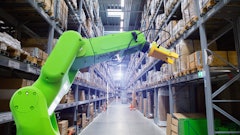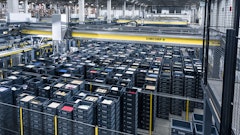
In today's business environment, uncertainty persists due to the unrelenting challenges associated with inflation, labor scarcity and supply chain delays. In the face of market volatility, automated equipment and processes improve operational efficiency by enabling consistent production, reducing costs and restoring predictability.
To ensure maximum production efficiency, a proactive equipment maintenance program is an essential element of automation. The most effective service programs use a combination of mechanical preventative maintenance improvements and insights from a broad network of related digital production data.
The true cost of disruption
Unscheduled downtime is the greatest disruptor to a consistent production process. A proactive approach to maintenance minimizes the risk and cost of unscheduled downtime and disruption.
Employee retention is a challenge for many operations and unscheduled downtime often results in unplanned overtime and higher rates of absenteeism. Short-term cost savings on delaying maintenance activities often results in much higher operating costs.
By proactively preventing issues before they happen, companies can win by avoiding costly downtime and improving yield rates.
Think about preventive maintenance the same way you think about maintaining your health with yearly health checkups. Being proactive with your health is a giant step toward protecting your longevity and well-being. Missed checkups may mean a missed opportunity to treat a relatively simple issue before it becomes a serious problem.
The same goes for protecting the health of your business. A proactive approach to equipment maintenance means you'll prevent issues that can cost time and money; it's about preventing a catastrophic issue, which causes downtime that may seriously hurt the health of your business.
Labor scarcity drives need for automation
Labor shortages have been an ongoing challenge, and some companies report labor turnover rates of as much as 130% per year. In an economy that’s in a state of flux, finding and keeping good maintenance people likely will only get worse.
Automation can help answer labor problems, but maintenance workers are hard to retain and often are not skilled at working with complex mechanical or electronic equipment.
Furthermore, plants don't rebuild these complex machines often enough for the maintenance team to become experts at rebuilding them. It is usually all they can do to keep the machines adequately greased, the oil changed on time, and the seal tape replaced as needed. Doing heavy-duty work is becoming too complicated and time-consuming for plants.
An outsourced maintenance program staffed by experts with the technical know-how to service complex automated equipment can be a game-changer and help these understaffed, inexperienced maintenance teams by doing the yearly rebuilds for the plants.
A prescription for profitability
From keeping operating budgets in check and equipment running efficiently to increasing customer satisfaction, proactive preventive maintenance offers several benefits.
- Overall cost savings. With preventive maintenance, overtime costs are reduced due to working on a scheduled basis as opposed to a responsive basis to repair breakdowns. Additionally, the sourcing of spare parts and labor can be planned and purchased more economically in advance. Otherwise, companies pay a premium for emergency parts shipping, travel time, and after-hours support.
- Reduced energy costs. Preventive maintenance enhances the efficiency of equipment and reduces energy costs by keeping it running more effectively. When equipment is not properly maintained, it uses more energy. Doing simple things like greasing moving parts or changing filters can reduce energy consumption.
- Increased uptime. Fewer machine breakdowns mean production downtime is minimized. And with the ability to schedule planned maintenance work during slower periods, there is less disruption to production schedules.
- Enhanced efficiency and customer satisfaction. When equipment runs smoothly and consistently, everyone benefits. Regular maintenance checkups help minimize any disruption to production schedules so that customers receive consistent, reliable service.
- Look to the future. As automation takes center stage for packaging operations, forward-thinking maintenance programs that use data capture and remote connectivity for optimal machine performance become even more important to stay competitive.
Saving time and money with the right preventive maintenance program
Choosing the right maintenance program for your equipment is key to maintaining the health of your business.
Consider a proactive preventive service plan that provides the technical support and expertise to improve the operational efficiency of your equipment. Look for features such as regularly scheduled service visits, equipment audits and catastrophic parts coverage to help avoid unplanned expenses, increase uptime and improve yield rates.
In an advanced maintenance program, remote connectivity and data capture add another layer to help identify and address immediate issues and find opportunities for enhancement.
How a cloud-based maintenance platform works to improve operational efficiency
For example, when a packaging machine is down, if a maintenance service plan includes a cloud-based remote connection, the maintenance team can see the alarms, look at the production history, and in time, start predicting equipment failures based on the data that is being collected. With this information, it is much easier to determine the problems, troubleshoot the issue and call the plant with repair suggestions. This can dramatically help packaging operations reduce the amount of time they are down because they get remote help through a smart link to diagnose the issue more quickly.
Additionally, the production numbers gathered via the smart link will help companies better understand their packaging operations. They will be able to use the reporting to help drive operational improvements.
With an eye on the future health of your business, preventive maintenance services, enhanced by remote monitoring and cloud-based data analytics, can increase system uptime and overall operational efficiency, giving companies a leg up they need to reduce costs and stay competitive in today's environment.





















